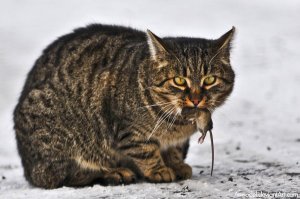 I came across an article in the Journal of American Veterinary Medicine Association (JAVMA) to help emphasize the point that cats are obligate carnivores and NEED to eat animal matter. The article is called “The carnivore connection to nutrition in cats” and it was written by a veterinarian. I’ll highlight a few of the important parts:
I came across an article in the Journal of American Veterinary Medicine Association (JAVMA) to help emphasize the point that cats are obligate carnivores and NEED to eat animal matter. The article is called “The carnivore connection to nutrition in cats” and it was written by a veterinarian. I’ll highlight a few of the important parts:
Cats are strict carnivores that rely on nutrients in animal tissues to meet their specific and unique nutritional requirements
This is a straight-forward statement made by a veterinarian clearly acknowledging that fact that cats are true carnivores.
The natural diet of cats in the wild is a meat-based regimen (eg, rodents, birds) that contains little CHO; thus, cats are metabolically adapted to preferentially use protein and fat as energy sources.
As I’m sure many cat owners recognize, cats have retained their very powerful prey drive and will still eagerly hunt mice and birds. They may not always eat them, but that’s because we feed them so well as caregivers. But the emphasis here is on the fact that their natural diet contains little carbohydrates (CHO).
adult cats require 2 to 3 times more protein in their diet than adults of omnivorous species.
This is critical for cats, especially when it comes to feeding dry food. Choose a grain-free kibble with no lower than 35% protein for cats, but ideally choose a food such as Orijen with 40% or more protein with meat being the primary source of protein.
cats continue to use protein (eg, dispensable nitrogen in the form of gluconeogenic amino acids) for production of energy and in other metabolic pathways (eg, urea cycle), even in the face of low availability of proteins.
This is where there is a distinct difference between cats and dogs. Dogs can adapt to low protein since they are omnivores but cats cannot, they must have high availability of protein in their diet. The urea cycle is part of the production of urine – wonder why so many cats get urinary problems on low quality kibble diets?
cats also have need for increased amounts of specific amino acids in their diet: taurine, arginine, methionine, and cysteine. These specific amino acid requirements of cats have likely been determined on the basis that their natural diet contains an abundance of each of these specific amino acids
The physiology of cats is built such that it minimizes wasting energy by expecting an abundance of pre-made amino acids to be available through the diet. Omnivores like dogs and humans have developed metabolic pathways to enable us to create these amino acids when we are in need of them and we don’t get them from our diet.
cats lack salivary amylase, the enzyme responsible for initiating CHO digestion. In addition, cats also have low activities of intestinal and pancreatic amylase and reduced activities of intestinal disaccharidases that break down CHOs in the small intestines.
More evidence that the physiological makeup of the cat is meant to take in foods that are easy to break down and readily bioavailable. Proteins are relatively easy to breakdown compared to complex carbohydrates (CHOs). Most omnivores have salivary amylase to start the breakdown of carbs early since they are more difficult to breakdown.
The water needs of cats reflect their early status as desert-dwelling animals and their development as strict carnivores that obtain most of their water requirements from consumption of prey. Cats have a less sensitive response to thirst and dehydration than dogs or other omnivores, and they adjust their water intake to the dry-matter content of their diet rather than the moisture content.
I don’t know about you, but I rarely see my cats drink water compared to my dog. Kibble diets are unnaturally dry for cats and can lead to issues if your cat doesn’t make up for the lack of water in his diet. You can avoid these issues by soaking the kibble before feeding, mixing kibble with wet food or feeding raw food that will have a high moisture content.
The following table was taken from the article as well, and demonstrates the nutritional makeup of the cat’s natural diet – the rat carcass. AAFCO determines the minimum nutritional requirements for commercial pet foods which clearly does not match the composition of the natural diet. But nonetheless, as I already said, ideally try to choose a cat food that has 40% protein or higher. This can be difficult with canned cat food since the moisture dilutes the as-fed protein content on the label. But a canned food with about 9% as-fed protein will generally give your cat 40% dry-matter protein which is ideal.
The carnivore connection to nutrition in cats Debra L. Zoran Journal of the American Veterinary Medical Association, December 1, 2002, Vol. 221, No. 11, Pages 1559-1567Comparison of nutrients in selected diets consumed by cats
Nutrient
Rat carcass
Canned growth diet
Canned maintenance diet
AAFCO*
Protein (%)
55
45.2
49
26
Fat (%)
38.1
25.4
36.2
9.0
Carbohydrate(%)
9.1
19.9
6.9
–
Fiber (%)
1.2
2.9
0.6
–
Moisture (%)
63.6
75.6
69.6
–
Calcium (%)
1.15
.0.94
1.09
0.6
Phosphorus(%)
0.98
0.78
0.95
0.5
Vitamin A(U/kg)
84,800
–
–
5,000
Vitamin E(U/kg)
33
–
–
30
Thiamin(mg/kg)
5.8
–
–
5.0
Riboflavin(mg/kg)
10.7
–
–
4.0
Niacin(mg/kg)
156.6
–
–
60
Folic acid(mg/kg)
2.8
–
–
0.8
Pantothenic acid(mg/kg)
54.9
–
–
5.0
Cobalamin(µg/kg)
22.5
–
–
20
Iron (mg/kg)
288
–
–
80
Zinc (mg/kg)
71.4
–
–
75
*Nutrients are expressed on a dry-matter basis.
AAFCO = Association of American Feed Control Officials.
– = Not determined.


You must be logged in to post a comment.